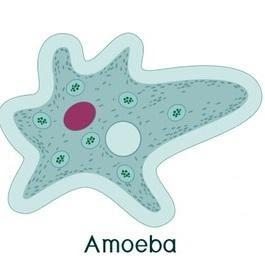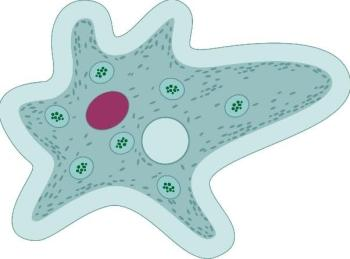
Answer
376.5k+ views
Hint: A unicellular organism, sometimes known as a single-celled organism, is a single-cell creature, as opposed to a multicellular organism, which has numerous cells. Prokaryotic organisms and eukaryotic organisms are the two types of unicellular creatures. Bacteria, Protozoa, Fungi, Algae, and Archaea Bacteria are among the unicellular organisms. Unicellular creatures have two modes of movement: movement and locomotion. An organism's form or shape can be changed through movement. Pseudopods are used to accomplish this. Pseudopods are used by protists, such as Amoeba, to collect nutrition and dispose of waste.
Complete explanation:
Option A: Yeasts are single-celled, eukaryotic microorganisms that belong to the fungal kingdom. Most yeasts reproduce asexually by mitosis, and many of them use the asymmetric division mechanism known as budding to do it. Molds, on the other hand, generate hyphae and yeasts grow single-celled growth habits.
So, option A is not correct.
Option B: the following picture is of Amoeba
It's a sort of cell or unicellular creature that can change its shape by extending and retracting pseudopods, for example. Amoebae are found in every major lineage of eukaryotic species and do not belong to a single taxonomic category. Amoeboid cells can be found in fungus, algae, and mammals, in addition to protozoa.
So, option B is the correct answer.
Option C: Spirogyra is a filamentous charophyte green alga of the Zygnematales order, so named because of the helical or spiral structure of the chloroplasts. Spirogyra can be found in a variety of freshwater settings, and there are over 400 species worldwide.
So, option C is not correct.
Option D: Amoeba resembles bacteria in appearance. Both are microorganisms with a single cell. Amoebas, on the other hand, have a significant distinction. They're eukaryotes, or multicellular organisms.
Many people who are sick have no symptoms at all since the Amoeba resides in their intestines and feeds on bacteria without creating any problems. In other cases, however, the parasite assaults the gut itself, resulting in potentially fatal diarrhea, ulcers, and liver abscesses.
So, option D is not correct.
Therefore, Option B is the correct answer.

Note:
The following characteristics are shared by the majority of Amoeba:
1. Pseudopodia are projections created when the cytoplasm pushes the plasma membrane outward or inward, resulting in blunt, finger-like projections.
2. Because many pseudopodia can exist at the same time, the shape of the pseudopod quickly changes.
3. The cytoplasm, plasma membrane, and nucleus are the three main components of structure of Amoeba.
4. The cytoplasm is divided into two layers: the ectoplasm on the outside and the endoplasm on the inside.
5. The plasma membrane is a double-layered membrane made up of protein and lipid molecules that is exceedingly thin.
6. Other cellular organelles found in Amoeba include a contractile vacuole, mitochondria, and Golgi apparatus.
7. The phagocytosis or pinocytosis processes are used by Amoebae to eat food.
Asexual reproduction, such as binary fission, is used to reproduce.
8. A typical Amoeba has a lifespan of two days, but because it performs binary fission, the resulting daughter cells are identical to the parent cell, Amoeba is technically immortal.
Complete explanation:
Option A: Yeasts are single-celled, eukaryotic microorganisms that belong to the fungal kingdom. Most yeasts reproduce asexually by mitosis, and many of them use the asymmetric division mechanism known as budding to do it. Molds, on the other hand, generate hyphae and yeasts grow single-celled growth habits.
So, option A is not correct.
Option B: the following picture is of Amoeba
It's a sort of cell or unicellular creature that can change its shape by extending and retracting pseudopods, for example. Amoebae are found in every major lineage of eukaryotic species and do not belong to a single taxonomic category. Amoeboid cells can be found in fungus, algae, and mammals, in addition to protozoa.
So, option B is the correct answer.
Option C: Spirogyra is a filamentous charophyte green alga of the Zygnematales order, so named because of the helical or spiral structure of the chloroplasts. Spirogyra can be found in a variety of freshwater settings, and there are over 400 species worldwide.
So, option C is not correct.
Option D: Amoeba resembles bacteria in appearance. Both are microorganisms with a single cell. Amoebas, on the other hand, have a significant distinction. They're eukaryotes, or multicellular organisms.
Many people who are sick have no symptoms at all since the Amoeba resides in their intestines and feeds on bacteria without creating any problems. In other cases, however, the parasite assaults the gut itself, resulting in potentially fatal diarrhea, ulcers, and liver abscesses.
So, option D is not correct.
Therefore, Option B is the correct answer.

Note:
The following characteristics are shared by the majority of Amoeba:
1. Pseudopodia are projections created when the cytoplasm pushes the plasma membrane outward or inward, resulting in blunt, finger-like projections.
2. Because many pseudopodia can exist at the same time, the shape of the pseudopod quickly changes.
3. The cytoplasm, plasma membrane, and nucleus are the three main components of structure of Amoeba.
4. The cytoplasm is divided into two layers: the ectoplasm on the outside and the endoplasm on the inside.
5. The plasma membrane is a double-layered membrane made up of protein and lipid molecules that is exceedingly thin.
6. Other cellular organelles found in Amoeba include a contractile vacuole, mitochondria, and Golgi apparatus.
7. The phagocytosis or pinocytosis processes are used by Amoebae to eat food.
Asexual reproduction, such as binary fission, is used to reproduce.
8. A typical Amoeba has a lifespan of two days, but because it performs binary fission, the resulting daughter cells are identical to the parent cell, Amoeba is technically immortal.
Recently Updated Pages
Who among the following was the religious guru of class 7 social science CBSE

what is the correct chronological order of the following class 10 social science CBSE

Which of the following was not the actual cause for class 10 social science CBSE

Which of the following statements is not correct A class 10 social science CBSE

Which of the following leaders was not present in the class 10 social science CBSE

Garampani Sanctuary is located at A Diphu Assam B Gangtok class 10 social science CBSE

Trending doubts
A rainbow has circular shape because A The earth is class 11 physics CBSE

Which are the Top 10 Largest Countries of the World?

Fill the blanks with the suitable prepositions 1 The class 9 english CBSE

What was the Metternich system and how did it provide class 11 social science CBSE

How do you graph the function fx 4x class 9 maths CBSE

Give 10 examples for herbs , shrubs , climbers , creepers

The Equation xxx + 2 is Satisfied when x is Equal to Class 10 Maths

What is BLO What is the full form of BLO class 8 social science CBSE

Change the following sentences into negative and interrogative class 10 english CBSE





